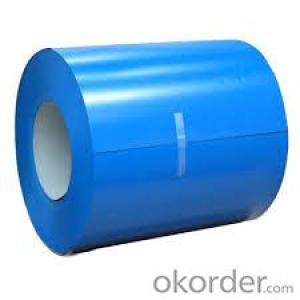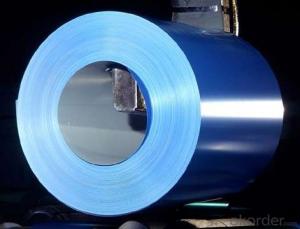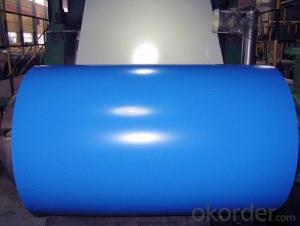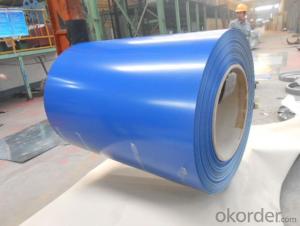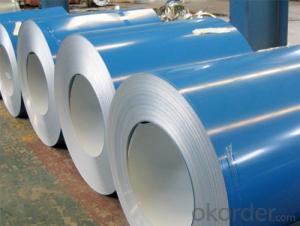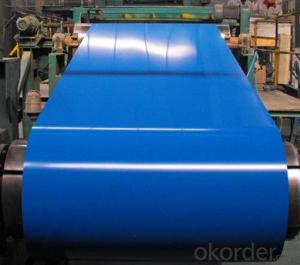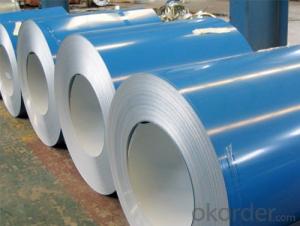Pre-Painted Galvanized/Aluzinc Steel Coils of Prime Quality in Blue Color
- Loading Port:
- Shanghai
- Payment Terms:
- TT OR LC
- Min Order Qty:
- 150 m.t.
- Supply Capability:
- 5000 m.t./month
OKorder Service Pledge
OKorder Financial Service
You Might Also Like
1. Pre-Painted Galvanized/Aluzinc Steel Coil Description:
With GI as base material, after pretreatment (degrease and chemical treatment ) and liquid dope with several layers of color, then after firing and cooling, finally the plate steel is called pre-painted galvanized (aluzinc) steel. Pre-painted galvanized steel is good capable of decoration, molding, corrosion resistance. It generally displays superior workability, durability and weather resistance.
2.Main Features of the Pre-Painted Galvanized/Aluzinc Steel Coil:
• Excellent process capability
• Smooth and flat surface
• Workability, durability
• Excellent heat resistance performance
• High strength
• Good formability
• Good visual effect
3.Pre-Painted Galvanized/Aluzinc Steel Coil Images
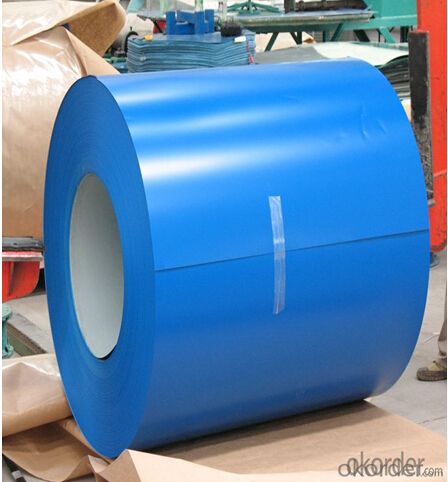
4.Pre-Painted Galvanized/Aluzinc Steel Coil Specification
Standard: AISI, ASTM, BS, DIN, GB, JIS
Grade: DX51D, DX52D
Thickness: 0.17-2.0mm
Brand Name: KMRLON
Model Number: coil
Type: Steel Coil
Technique: Cold Rolled
Surface Treatment: Coated
Application: Boiler Plate
Special Use: High-strength Steel Plate
Width: 20-1250mm
Length: customized
commoidty: pre-painted galvanized steel coil
Thickness: 0.13-4.0mm
width: 20-1250mm
zinc coating: 40-180g/m2
printing thickness: top side: 20+/-5 microns, back side: 5-7 microns
color: all RAL color
surface treatment: color coated
coil weight: 4-7 tons
coil ID: 508/610mm
packaging: standard seaworthy packing
5.FAQ of Pre-Painted Galvanized/Aluzinc Steel Coil
1. What’s the application of this product?
Roof, roof structure, surface sheet of balcony, frame of window, etc.
2. What’s the brand of the paint?
We use the best brand of all of the word—AKZO.
3. How to guarantee the quality of the products?
We have established the international advanced quality management system,every link from raw material to final product we have strict quality test;We resolutely put an end to unqualified products flowing into the market. At the same time, we will provide necessary follow-up service assurance.
4. How long can we receive the product after purchase?
Usually within thirty working days after receiving buyer’s advance payment or LC. We will arrange the factory manufacturing as soon as possible. The cargo readiness usually takes 15-25 days, but the shipment will depend on the vessel situation.
- Q: Many gerber knives are made out of what gerber calls high Carbon steels and I was wondering if anyone knew exactly what is this mysterious steel.
- A steel knifeblade is like a box full of a million ball bearings. The molecules pile up/line up just like those ball bearings. When it's pure, though, you can easily deform it....just like you can ram your hand down into that box of ball bearings. What happens if you pour a gallon of heated wax over those bearings, though? It fills the gaps between the molecules and solidifies the entire mass into one solid shape. If you smack it then, you'll break your hand. It'll hold its shape *much* better and longer. That's pretty basic but what do you expect at 04:00? ;) Addendum: At one time, in the late 80's to mid 90's, it was 440a...they then switched to 440c on their mass market stuff and 154 on their special runs....late 90's-2005 went to all 440c....today's knives are a mix of 440c and some pricier knives sporting S30V blades. If it's Gerber and it costs less than $40 today, 99% of the time it will be 440c.
- Q: Nickel is ferro magnetic in nature. But when it is added with stainless steel, it makes stainless steel non-magnetic. What is the structural changes happened with the presence of nickel?
- Dear Ian, Magnetism doesn't add up or average out in that manner. Ferro-magnetism requires that all the spins align. This is a complex effect and needs a subtle interaction between adjacent atoms in the lattice and their singlet electrons. The distance between the the atoms is what is important. Some stainless steels are ferromagnetic because they have the correct spacing, others are not because the spacing is wrong. This spacing is influenced by the makeup of the alloy. Hope that helps a bit:RufusCat Copyleft:RufusCat
- Q: im buying a sword and i dont know if i should buy a cold steel sword or a normal sword and that i can some how make that cold steel
- This Site Might Help You. RE: how are cold steel swords made? im buying a sword and i dont know if i should buy a cold steel sword or a normal sword and that i can some how make that cold steel
- Q: I am doing a project on how revolvers work and what materials they use and would like to know what specific grade of stainless steel they use for the manufacturing of the frame and cylinder?
- *Rifle barrels are usually made from steel alloys called ordinance steel, nickel steel, chrome-molybdenum steel, or stainless steel, depending upon the requirements of the cartridge for which they are chambered. The higher the pressure and velocity of a cartridge (pressure and velocity usually go up together), the faster it will wear out a barrel. To give a satisfactory service life, barrels for high velocity cartridges must me made from tougher and harder steel than barrels for lower pressure cartridges. *The 400 (416) series SS commonly known as ordnance grade , is what barrels are made from . *If you want your barrel to be made from super alloy then it is 718 Inconel ,but a costly affair.
- Q: What are the different methods of testing the mechanical properties of steel coils?
- There are several methods available for testing the mechanical properties of steel coils. These methods are crucial for determining the strength, ductility, and overall quality of the steel. Some of the commonly used methods include: 1. Tensile testing: This method involves applying a tensile force to a steel coil until it fractures. The test measures the maximum stress a material can withstand before breaking, as well as its elongation and reduction in cross-sectional area. Tensile testing provides important information about the ultimate tensile strength, yield strength, and elongation of the steel coil. 2. Hardness testing: Hardness testing determines the resistance of a material to indentation or scratching. Numerous methods are available for measuring the hardness of steel coils, such as Brinell, Vickers, and Rockwell hardness tests. These tests provide an indication of the steel's ability to resist deformation and wear. 3. Bend testing: Bend testing involves subjecting a steel coil to a controlled bending force until it reaches a specified angle or until a crack appears. This test assesses the ductility and flexibility of the steel, as well as its resistance to cracking or fracture under bending stress. 4. Impact testing: Impact testing measures the ability of a steel coil to absorb energy when subjected to a sudden shock or impact. The most commonly used method is the Charpy impact test, where a notched specimen is struck by a pendulum hammer, and the energy absorbed during fracture is measured. This test evaluates the toughness and resistance to brittle fracture of the steel coil. 5. Fatigue testing: Fatigue testing involves subjecting a steel coil to repeated or cyclic loading to simulate the stresses it may encounter during its intended use. This test assesses the steel's resistance to fatigue failure and its ability to withstand repeated stress over an extended period. 6. Ultrasonic testing: Ultrasonic testing utilizes high-frequency sound waves to detect defects or flaws in the steel coil. This non-destructive testing method can identify internal or surface defects, such as cracks, voids, or inclusions, which may affect the mechanical properties of the steel. It is important to note that these testing methods are often performed in accordance with industry standards and specifications, such as ASTM (American Society for Testing and Materials) or ISO (International Organization for Standardization) standards, to ensure accurate and reliable results.
- Q: How are steel coils used in the manufacturing of steering columns?
- Steel coils are used in the manufacturing of steering columns as they provide strength and durability to the structure. The steel coils are typically formed into a cylindrical shape and then welded or joined together to create the main body of the steering column. This ensures that the steering column can withstand the forces and impacts experienced during vehicle operation, providing stability and control to the driver.
- Q: How are steel coils used in the manufacturing of electrical components?
- Steel coils are used in the manufacturing of electrical components as they provide a strong and reliable core for various types of transformers and inductors. These coils are often wound around a steel core to enhance magnetic properties and improve efficiency, allowing for the transformation and transfer of electrical energy.
- Q: I plan to buy a bushcraft knife ..The blade made up by damascus steel.My question is ,is damascus steel is very strong ?
- Pattern welded /damascus is too expensive to use as an everyday knife, as it can cost more than silver. It's best kept as a collection piece. You'd be stupid to keep it in your pocket or use it everyday. that would be a waste of money. Knives you use everyday might be lost or stolen, or they may get rusted, worn, or dirty..... ruining their value. From that point of view the strength or edge-holding ability means very little. Specifically, the bushcraft knife is pattern welded steel. True damascus or Wootz steel is something you'll only find in museums and private collections. they stopped making it several hundred years ago. Despite what many people have claimed, Wootz damascus was inferior to modern tool steels in every respect. It was a brittle, dirty material. It's legendary status has more to do with myth and storytelling. The reason they stopped making was undoubtaby because more modern methods came along that produced a more consistent product, more quickly and easily. Old technologies tend to be abandoned for good reasons. With pattern welded steel, about a dozen strips of two different grades of steel have been stacked, welded together, the twisted and forged to create interesting patterns. This more of an artistic process and doesn't improve the properties of modern steels. Pattern welded steel is for the most part, inferior to a homogenous blade made of a single grade of steel. First of all, PW is a handmade product which means there will be faults and oxide inclusions incorporated into the steel. The welding process is not perfect. Secondly, in the hardening and tempering process you end up with a compromise between the properties of the two different grades of steel. You end up with a product that is not quite as good as either steel would have been individually. The blade may either be too brittle or too soft.
- Q: what do we use steel for and whyand why do we use brass for instrumentsplz help its homework and i cant find the answer anywhere : (
- Brass and steel are type of metals that mostly use for moist area and also have luxury used cause of ability of shine .Steel definitely is for anti oxide ,mostly use in area that food and liquid such as acid ,milk ,soda,water are in contact .Brass most use for electric parts and decoration for ability of conductivity and shin .
- Q: Is infi steel as good as busse knives make it sound. If so why don't any other brands use it. Also are there any tactical folders that use infi steel. If infi isn't as good as it's cracked up to be then what is the best alternative.
- infi is a brand name steel. They have it specially made and the composition is supposed to be a secret though it is similar to 52100. I have used knives from Busse and their sister company Swamprat Knives. Both companies make good knives, even if their advertising may be a bit odd. They are pricey, but are also very good knives with good steel and ergonomics. If you have the money they are a good option. I don't know if Swamprat still makes knives, but I have a 4'' folder from them in s30v that is great. Benchmade makes some great knives as well, though not nearly a custom as Busse. Take a look at the 913, a 3.6'' D2 blade that was a spring release and G10 handle for a good price. An excellent knife.
Send your message to us
Pre-Painted Galvanized/Aluzinc Steel Coils of Prime Quality in Blue Color
- Loading Port:
- Shanghai
- Payment Terms:
- TT OR LC
- Min Order Qty:
- 150 m.t.
- Supply Capability:
- 5000 m.t./month
OKorder Service Pledge
OKorder Financial Service
Similar products
Hot products
Hot Searches
Related keywords
